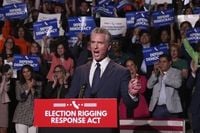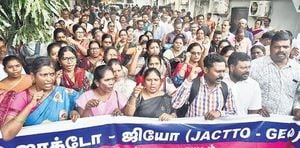California’s political landscape is bracing for a seismic shift as Democrats push forward with a controversial plan to redraw the state’s congressional districts, aiming to bolster their chances of reclaiming the U.S. House of Representatives in the 2026 midterm elections. The proposed map, unveiled on August 15, 2025, is designed to add five Democratic seats and drastically curtail Republican influence, igniting a fierce debate about the future of fair representation and the role of partisan redistricting.
The new map, crafted by the Democratic Congressional Campaign Committee with data consultant Paul Mitchell at the helm, keeps California’s 52 congressional districts intact in number but radically reconfigures their boundaries. According to ABC10, the plan specifically targets five Republican incumbents—Kevin Kiley, Doug LaMalfa, David Valadao, Darrell Issa, and Ken Calvert—while shoring up vulnerable Democratic seats such as Adam Gray’s in the Central Valley. Only four Republicans—Tom McClintock, Vince Fong, Jay Obernolte, and Young Kim—would remain in what are considered ‘safe’ districts.
“There’s the changes where we sought to increase the partisanship of a district so that we could get a Democrat elected in order to combat what Trump is doing,” Mitchell explained to ABC10. “Then there’s the other districts, where you might see people moving because of all the other movements.”
The timing of California’s move is anything but accidental. It comes as Texas Republicans, spurred on by former President Donald Trump, attempt to redraw their own congressional maps to maintain the GOP’s slim House majority. The Texas effort has been stymied by Democratic walkouts, but California’s rapid action is expected to spur lawmakers in Texas to return and press ahead with their plans. As The Associated Press reports, both parties are hoping to net five seats for their side, and the outcome could tip the balance of power in Congress.
Governor Gavin Newsom, who is spearheading the campaign for the new maps, has made no secret of the partisan stakes. “We anticipate these maps will completely neuter and neutralize what is happening in Texas,” Newsom declared. “Donald Trump does not play fair. You’ve seen that happen over and over again, and I’m just not going to sit back and be complicit.”
But the plan faces significant hurdles before it can become law. The map must first be approved by California’s Democratic supermajority in the state Legislature—a vote expected as early as August 21, 2025—and then by voters in a special statewide election scheduled for November 4, 2025. Lawmakers are moving swiftly, with hearings slated for August 19 and 20 and an ambitious timeline to ensure ballots are ready for the fall vote. The cost of the special election is steep, with estimates topping $235 million, and local officials are already requesting advance funds to manage the logistical challenge of printing and distributing ballots to every registered voter.
At the heart of the controversy is California’s independent redistricting commission, established by voters in 2010 to remove partisan influence from the drawing of district lines. The commission last redrew maps after the 2020 Census, and its boundaries were used for the 2022 and 2024 elections. Newsom’s proposal would temporarily suspend the commission’s authority for the next three election cycles, with a promise to return mapmaking power to the commission after the 2030 Census.
That promise has done little to quell criticism from Republicans and good-government advocates. Congressman Kevin Kiley, one of the Republicans most threatened by the new map, told ABC10 he believes voters will reject the plan. “They want to keep the independent citizens commission in place. They want to keep our district lines as they were drawn by that independent commission. They don’t want to go back to the era of partisan gerrymandering with self-interested politicians drawing the lines themselves,” Kiley argued. He also pledged, “Make no mistake; I will run for and win re-election, regardless of the Governor’s attempt to slice up and gerrymander my district.”
Doug LaMalfa, another targeted Republican, was even more blunt in his criticism. “How on earth does Modoc County on the Nevada and Oregon Border have any common interest with Marin County and the Golden Gate Bridge?” LaMalfa wrote on X, calling the proposal “naked politics at its worst.” The new 1st Congressional District, which LaMalfa has represented since 2013, would stretch from rural counties along the Oregon border south into liberal Sonoma County, including Santa Rosa—an area currently held by Democratic Rep. Mike Thompson.
Democratic leaders, meanwhile, frame the fight as an existential battle for democracy. “This is about more than drawing lines on a map. It’s about drawing a line in the sand to stop Texas and Trump from rigging the election,” state Senate Democratic leader Mike McGuire said, as reported by CBS Sacramento.
The proposed changes are not limited to Northern California. In the Central Valley, the competitive 13th District, held by Democrat Adam Gray, would be redrawn to extend into Stockton, picking up more Democratic voters and likely securing Gray’s reelection. This adjustment has a domino effect, pulling the 22nd District—currently held by Republican David Valadao—north toward Fresno and adding more Democratic voters there as well. As Mitchell described it, “That finger up into Stockton is a key feature of making all the puzzle pieces fall in place in the Central Valley.”
Southern California would also see dramatic changes, particularly in the 41st District, where Republican Ken Calvert faces a district transformed by the addition of liberal Palm Springs. Democratic registration in the district would leap to 46%, with GOP registration falling to 26%, according to Los Angeles Times reporting.
Opponents of the plan are mobilizing for a legal and political fight. Former Governor Arnold Schwarzenegger, who championed the independent commission, posted a photo of himself on social media wearing a T-shirt reading “Terminate gerrymandering,” signaling his intent to oppose the measure. Republican donor Charles Munger Jr., a key supporter of the commission, also plans to “vigorously defend” nonpartisan redistricting. Steve Hilton, a Republican candidate for governor, has already secured a legal opinion arguing that the proposed mid-decade redistricting violates the state constitution because it relies on outdated population data.
Even Common Cause, a nonpartisan group that initially opposed the partisan redistricting effort, has softened its stance, saying it won’t challenge the plan if voters approve it and other criteria are met.
As the November special election approaches, both sides are preparing for an intense campaign that will likely serve as a referendum not only on the maps themselves but on the broader questions of partisan power and the integrity of American democracy. With control of the House potentially hinging on just a handful of seats, the outcome in California could reverberate across the nation.
As the dust settles, all eyes will be on California voters, whose decision will determine not just the state’s political future, but perhaps that of the entire country.






